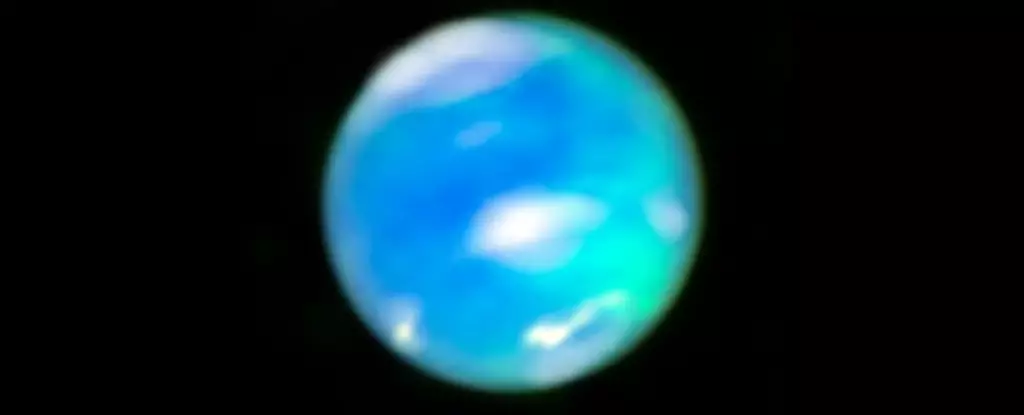The immense vastness of our Solar System harbors numerous wonders, and among the most enchanting is the elusive phenomenon known as auroras. Far beyond the enticing visuals seen on Earth, these celestial light displays vary dramatically from one planet to another, showcasing a universe where the relationship between solar winds and magnetic fields creates a spectacle of beauty. In a groundbreaking revelation, the James Webb Space Telescope (JWST) has shone a light on Neptune, the furthest planet from the Sun, capturing its remarkable aurora for the first time in stunning near-infrared detail. This momentous development not only enriches our understanding of Neptune but also embarks on a journey through how auroras manifest across the Solar System’s diverse planets.
Understanding Auroras: A Celestial Phenomenon
Auroras are a spectacular consequence of the interaction between charged particles from the solar wind and a planet’s magnetic field. On Earth, for instance, when these energetic particles collide with atmospheric gases, colorful lights paint the night sky—a dazzling spectacle that has fascinated humanity for centuries. Meanwhile, Jupiter, with its robust magnetic field, showcases the most powerful auroras known, continuously sending forth bursts of ultraviolet light. This variability begs an essential question: how do these glowing phenomena differ on distant planets like Neptune?
Neptune’s ambient auroras can be particularly challenging to study, given its remoteness from the Sun. Uranus and Neptune, both situated at significant distances, had once left researchers wondering if these gas giants even exhibited such phenomena. The magnetic fields of these two planets are notably chaotic and lopsided, with auroras primarily emanating from regions near the equator rather than the poles. This unique feature emphasizes the adaptability of auroras to their planetary environments, igniting curiosity about their forms on exoplanets flourishing around distant stars.
The JWST Breakthrough and Its Implications
The JWST’s recent efforts have unveiled Neptune’s atmosphere in exquisite detail, highlighting a previously unseen aurora near the planet’s equator. The discovery is tied to the detection of trihydrogen cation (H3+), a molecular component associated with auroral activity. Through meticulous observations, astronomers led by Henrik Melin from Northumbria University were able to pinpoint the locations of these ethereal displays. Such findings are significant, as they establish a tangible connection between distant planetary atmospheres and solar influences, expanding our grasp of how celestial equations play out in the universe.
Moreover, the implications of these discoveries extend far beyond mere planetary beauty; they challenge previous assumptions about the cooling rates of gas giants. The new datasets collected by JWST indicate that Neptune has cooled considerably since the encounters of the Voyager 2 mission back in 1989. This revelation is pivotal, as cooler temperatures can result in fainter auroras. As a result, previous searches may have missed detecting Neptune’s dazzling displays due to our misunderstanding of its thermal characteristics.
Broader Impacts on Astronomy and Exoplanet Studies
Neptune’s newfound auroral dance is not just a triumph of planetary science; it represents an evolutionary step for our understanding of atmospheric phenomena across varying worlds. The conditions that govern these auroras can also provide insights into the atmospheres of exoplanets—those rocky and gaseous worlds orbiting distant stars that humanity has only recently begun to explore. Just as displays of light change in response to solar activity on our own planets, we might find similar—albeit different—patterns elsewhere in our galaxy.
Excitingly, the cataloging of auroras across the Solar System—from Mercury’s peculiar X-ray fluorescence to Saturn’s glowing hues—enhances our understanding of solar interactions universally and offers a compelling narrative to study. Now armed with advanced tools like the JWST, researchers can observe and disseminate knowledge about auroral activity not just within our Solar System but beyond. The universe beckons with secrets waiting to be unearthed, inviting both seasoned scientists and enthusiastic space explorers to delve deeper into the cosmic tapestry.
Unquestionably, Neptune’s aurora is a testament to the intricate and interconnected nature of our cosmos, revealing that awe-inspiring spectacles exist in the farthest reaches of space. The beauty of these heavenly lights not only ignites a sense of wonder but also spurs humanity’s relentless quest for understanding our place in the ever-expanding universe.


Leave a Reply